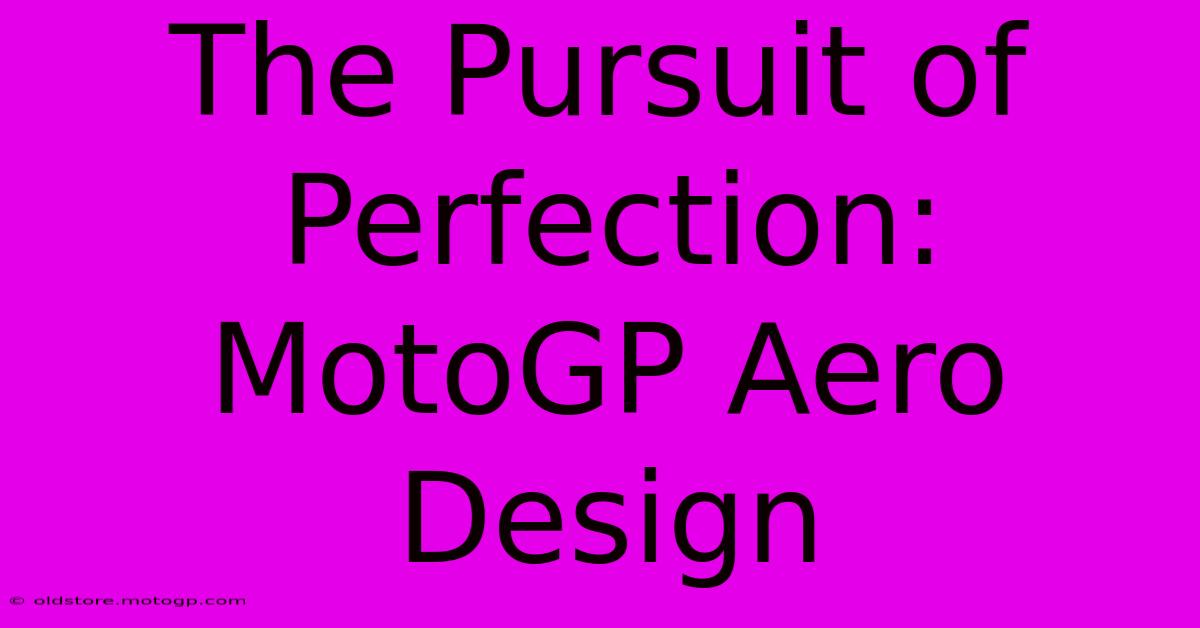The Pursuit Of Perfection: MotoGP Aero Design

Table of Contents
The Pursuit of Perfection: MotoGP Aero Design
The roar of the engines, the blur of speed, the breathtaking skill – MotoGP is a spectacle of power and precision. But beyond the raw talent of the riders lies a crucial element often overlooked: aerodynamic design. The relentless pursuit of aerodynamic perfection is a constant battle in MotoGP, a quest for those crucial tenths of a second that separate victory from defeat. This article delves into the intricate world of MotoGP aero design, exploring its complexities and impact on the sport.
The Science of Speed: Understanding MotoGP Aerodynamics
MotoGP bikes are not just fast; they're designed to stay fast. Aerodynamics plays a pivotal role in achieving this. The bikes, traveling at speeds exceeding 200 mph, face immense air resistance. Every detail, from the fairing's shape to the smallest winglet, is meticulously engineered to minimize drag and maximize downforce.
Minimizing Drag: The Key to Top Speed
Drag, the force opposing a vehicle's motion through the air, is the enemy of speed. MotoGP engineers employ various strategies to reduce drag, including:
- Streamlined Fairings: The fairing's shape is paramount. Its design is optimized using Computational Fluid Dynamics (CFD) simulations to minimize air resistance and create a smooth airflow over the bike. Even minor imperfections can significantly impact performance.
- Winglet Optimization: While winglets generate downforce (discussed below), their design must also consider drag. The shape, size, and angle of attack are carefully calibrated to maximize downforce while minimizing the drag penalty.
- Surface Texture and Material: Even the surface texture of the fairing plays a role. Smooth surfaces minimize turbulence, reducing drag and improving overall efficiency. The choice of materials also influences both weight and aerodynamic performance.
Maximizing Downforce: Cornering at the Limit
Downforce, the force pushing the bike towards the track, is crucial for high-speed cornering. The higher the downforce, the greater the grip and the faster the rider can take corners. This is achieved primarily through:
- Aerodynamic Winglets: These small wings generate downforce by deflecting air downwards. Their design is incredibly complex, with adjustments made based on the track characteristics and riding style.
- Underbody Aerodynamics: The underbody of the bike also contributes significantly to downforce. Smooth airflow under the bike helps create a low-pressure zone, increasing the downward force.
- Fairing Design: The overall shape of the fairing also influences downforce. A carefully sculpted fairing can direct airflow to create areas of high and low pressure, optimizing the balance between downforce and drag.
The Constant Evolution: Innovation in MotoGP Aero Design
MotoGP aero design is a constantly evolving field. Teams are constantly experimenting with new ideas and technologies to gain a competitive edge. This includes:
- Computational Fluid Dynamics (CFD): CFD simulations allow engineers to test and refine designs virtually, saving time and resources. They provide detailed insights into airflow patterns, allowing for precise optimization.
- Wind Tunnel Testing: Wind tunnel testing provides crucial real-world validation of CFD simulations. It allows engineers to fine-tune designs and assess their performance under various conditions.
- Material Science Advancements: The use of lightweight yet strong materials, such as carbon fiber composites, is essential for achieving optimal aerodynamic performance without sacrificing structural integrity.
The Rider's Perspective: Aero's Impact on Handling
While the engineers design the aero package, the rider ultimately interacts with it. The downforce generated affects the bike's handling, requiring the rider to adapt their riding style to maximize the benefits. The feedback loop between rider and engineer is crucial for optimizing aerodynamic performance.
Conclusion: A Symphony of Speed and Science
The pursuit of perfection in MotoGP aero design is a testament to the dedication and ingenuity of engineers and teams. The intricate interplay of drag reduction, downforce generation, and rider feedback creates a fascinating blend of science and sport. The quest for those precious tenths of a second continues, driving innovation and pushing the boundaries of what's possible. The next evolution in MotoGP aero design is always just around the corner.

Thank you for visiting our website wich cover about The Pursuit Of Perfection: MotoGP Aero Design. We hope the information provided has been useful to you. Feel free to contact us if you have any questions or need further assistance. See you next time and dont miss to bookmark.
Featured Posts
-
Moto Gp Qualifying How Riders Earn Their Place On The Grid
Feb 23, 2025
-
Cota Parking Save Time And Money
Feb 23, 2025
-
Premium Formula 1 Parking Elevate Your Race Day
Feb 23, 2025
-
Cota Transportation Hacks Beat The Traffic
Feb 23, 2025
-
The Definitive Guide To F1 Us Grand Prix Tv Coverage 2023
Feb 23, 2025
